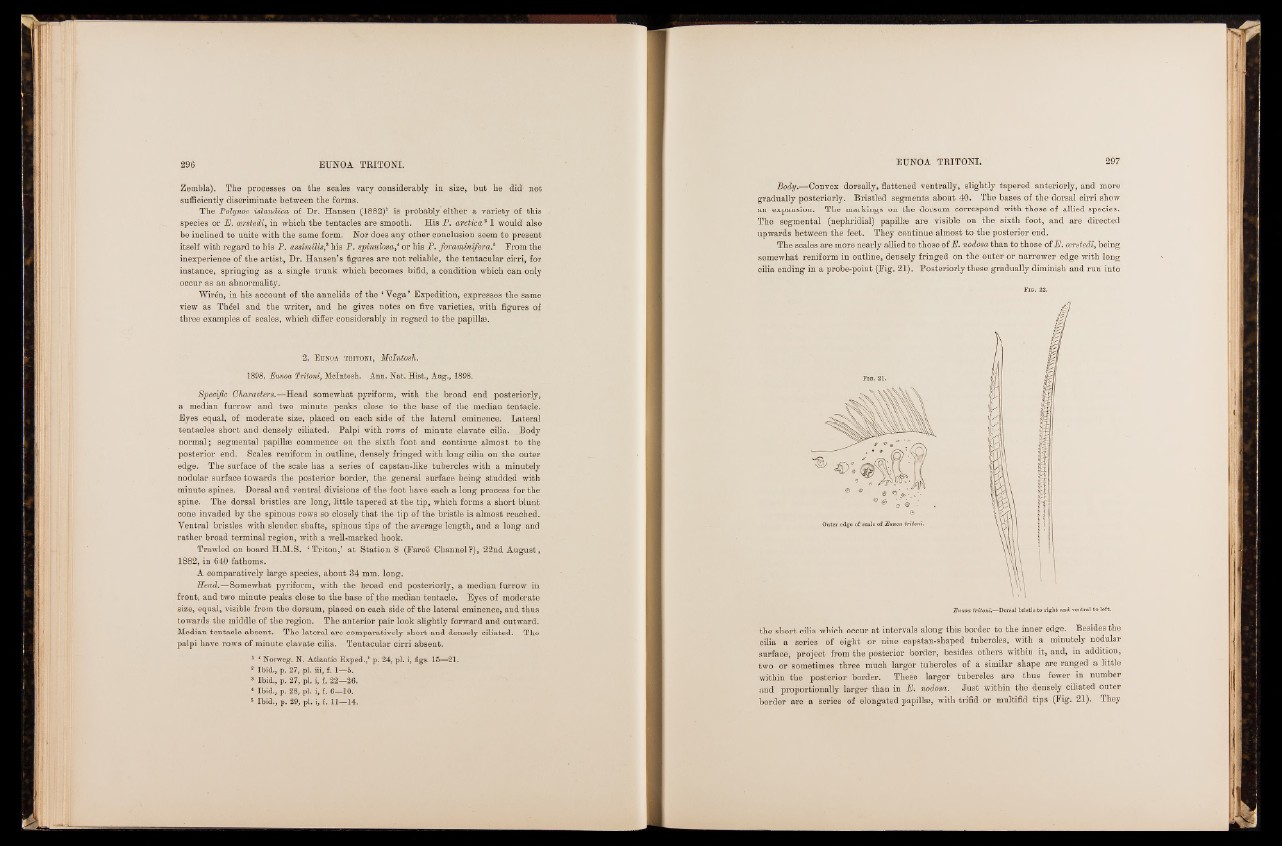
Zembla). The processes on the scales vary considerably in size, but he did not
sufficiently discriminate between the forms.
The Polyno'e islandica of Dr. Hansen (1882)1 is probably either a variety of this
species or E. cerstedi, in which the tentacles are smooth. His P. arctica21 would also
be inclined to unite with the same form. Nor does any other conclusion seem to present
itself with regard to his P. assimilis,8 his P. spinulosa* or his P. foraminifera.6 From the
inexperience of the artist, Dr. Hansen’s figures are not reliable, the tentacular cirri, for
instance, springing as a single trunk which becomes bifid, a condition which can only
occur as an abnormality.
Wir^n, in his account of the annelids of the ‘ Yega ’ Expedition, expresses the same
view as Th<5el and the writer, and he gives notes on five varieties, with figures of
three examples of scales, which differ considerably in regard to the papillae.
2, E tjnoa t e i t o n i , McIntosh.
1898. Eunoa Tritoni, McIntosh. Ann. Nat.' Hist., Aug., 1898.
Specific Characters.—Head somewhat pyriform, with the broad end posteriorly,
a median furrow and two minute peaks close to the base of the median tentacle.
Eyes equal, of moderate size, placed on each side of the lateral eminence: Lateral
tentacles short and densely ciliated. Palpi with rows of minute clavate cilia. Body
normal; segmental papillae commence on the sixth foot and continue almost to the
posterior . end. Scales reniform in outline, densely fringed with long cilia on the outer
edge. The surface of the scale has a series of capstan-like tubercles with a minutely
nodular surface towards the posterior border, the general surface being studded with
minute spines. Dorsal and ventral divisions of the foot have each a long process for the
spine. The dorsal bristles are long, little tapered at the tip, which forms a short blunt
cone invaded by the spinous rows so closely that the tip of the bristle is almost reached.
Ventral bristles with slender, shafts, spinous tips of the average length, and a long and
rather broad terminal region, with a well-marked hook.
Trawled on board H.M.S. ‘Triton,’ at Station 8 (Faroe Channel?), 22nd August,
1882, in 640 fathoms.
A comparatively large species, about 34 mm. long.
Head.—Somewhat pyriform, with the broad end posteriorly, a median furrow in
front, and two minute peaks close to the base of the median tentacle. Eyes of moderate
size, equal, visible from the dorsum, placed on each side of the lateral eminence, and thus
towards the middle of the region. The anterior pair look slightly forward and outward.
Median tentacle absent. The lateral are comparatively short and densely ciliated. The
palpi have rows of minute clavate cilia. Tentacular cirri absent.
1 ‘ Norweg. N. Atlantic Exped.,’ p. 24, pi. i, figs. 15—21.
2 Ibid., p. 27, pi. iii, f. 1—5.
8 Ibid., p. 27, pi. i, f. 22—26.
4 Ibid., p. 28, pi. i, f. 6—10.
6 Ibid., p. 29, pi. i, f. 11—14.
Body.—Convex dorsally, flattened ventrally, slightly tapered anteriorly, and more
gradually posteriorly. Bristled segments about 40. The bases of the dorsal cirri show
an expansion. The markings on the dorsum correspond with those of allied species.
The segmental (nephridial) papillae are visible on the sixth foot, and are directed
upwards between the feet. They continue almost to the posterior end.
The scales are more nearly allied to those of E. nodosa than to those of E. cerstedi, being
somewhat reniform in outline, densely fringed on the outer or narrower edge with long
cilia ending in a probe-point (Fig. 21). Posteriorly these gradually diminish and run into
Fig. 22.
Eunoa tritoni.—Dorsal bristle to r ight and ventral to left.
the short cilia which occur at intervals along this border to the inner edge. Besides the
cilia a Series of eight or nine capstan-shaped tubercles, with a minutely nodular
surface, project from the posterior border, besides others within it, and, in addition,
two or sometimes three much larger tubercles of a similar shape are ranged a little
within the posterior border. These larger tubercles £tre thus fewer in number
and proportionally larger than in E* nodosa. Just within the densely ciliated outer
border are a series of elongated papillas, with trifid or multifid tips (Fig. 21). They